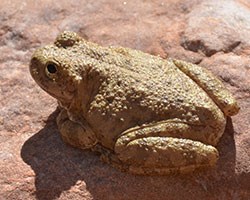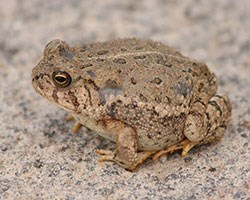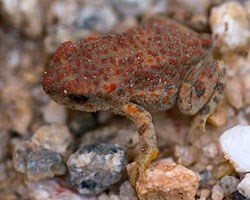|
The most common amphibians in the park are the canyon treefrog (Hyla arenicolor), red-spotted toad (Anaxyrus punctatus), and Woodhouse's Rocky Mountain toad (Anaxyrus woodhousii). These are all riparian (streamside) species which rely on the Colorado River and its perennial tributaries in the park for breeding, since their egg-masses and tadpoles are water-bound. Although these common species require water sources, they are far more tolerant of desiccation than most other amphibians. Red-spotted toads have been found as far as one-half mile from the nearest known water source. Northern leopard frogs (Rana [Lithobates] pipiens), which are also riparian species, are native but very rare to the Colorado River corridor. Efforts to reintroduce this species, which experienced population declines following the building of Glen Canyon Dam, are currently underway.
The Great Basin spadefoot (Spea intermontana) is a common species to the coniferous forests on the rim of the Grand Canyon. They live near moist grasslands near ponds or near stock tanks on the North Rim and are found in more mesic habitats on the South Rim. The Great Plains toad (Anaxyrus cognatus) may also be found in rim forests but is rare and seldom seen. 
Canyon Treefrog

Woodhouse's Rocky Mountain Toad

Red-spotted Toad
Facts about Frogs and Toads:
Select a Park:Select a Species Category (optional):
Search results will be displayed here.
Endangered,Threatened, and Sensitive Wildlife1 According to 66 FR 54808, 50 CFR 17.11-17.12, AGFD 2003
2 Federal Status: E Endangered, in danger of extinction T Threatened, severely depleted C Candidate for listing as threatened or endangered XN Experimental non-essential population SC Species of Concern. Some information showing vulnerability or threat, but not enough to support listing 3 State Status: WSCA – Wildlife of Special Concern in Arizona 4 Navajo Endangered Species List: Group 1 (G1): No longer occurs on the Navajo Nation. Group 2 (G2): Prospect of survival or recruitment is in jeopardy. Group 3 (G3): Prospect of survival or recruitment is likely to be in jeopardy in the foreseeable future.
|
Last updated: September 5, 2023
